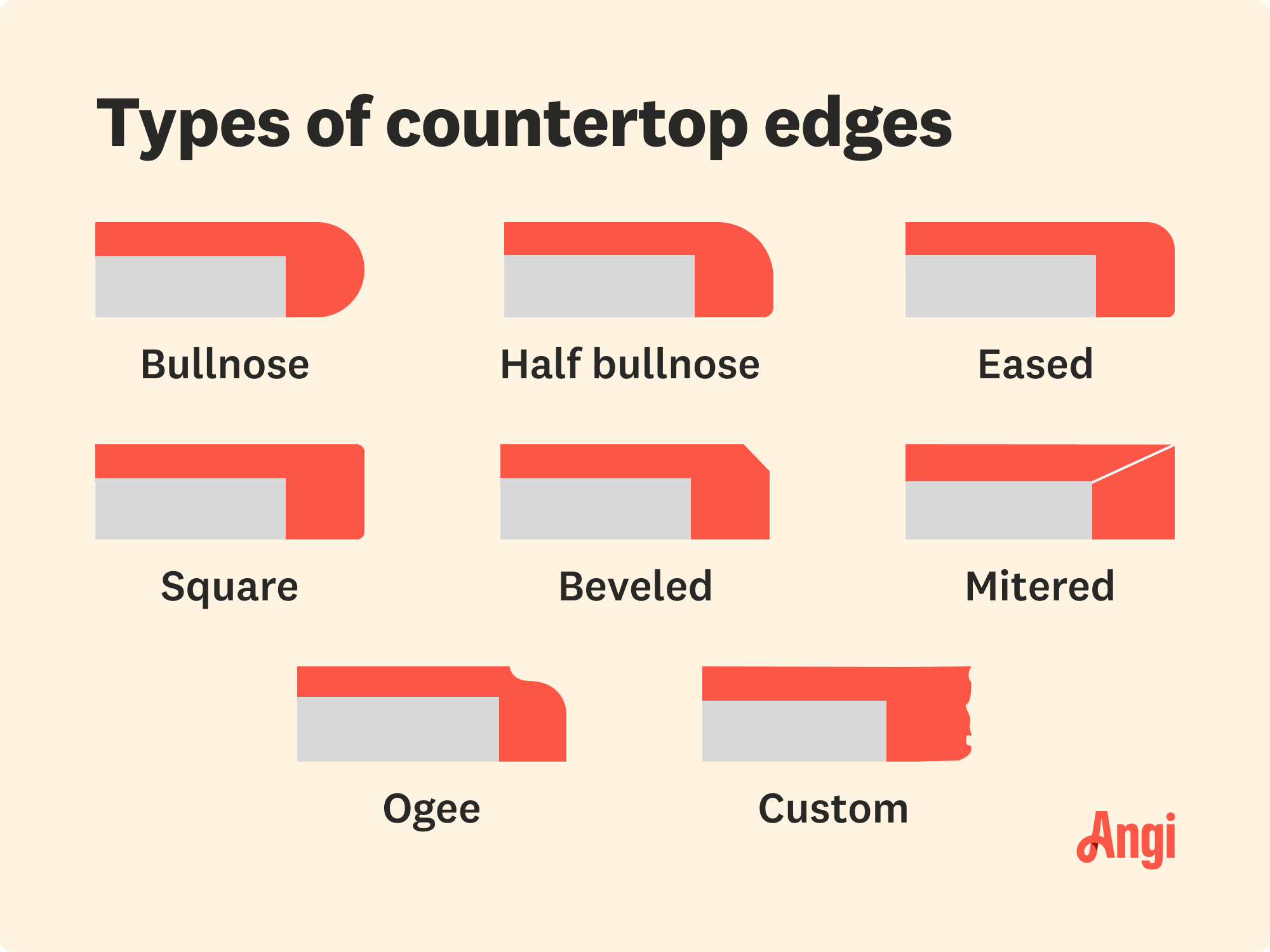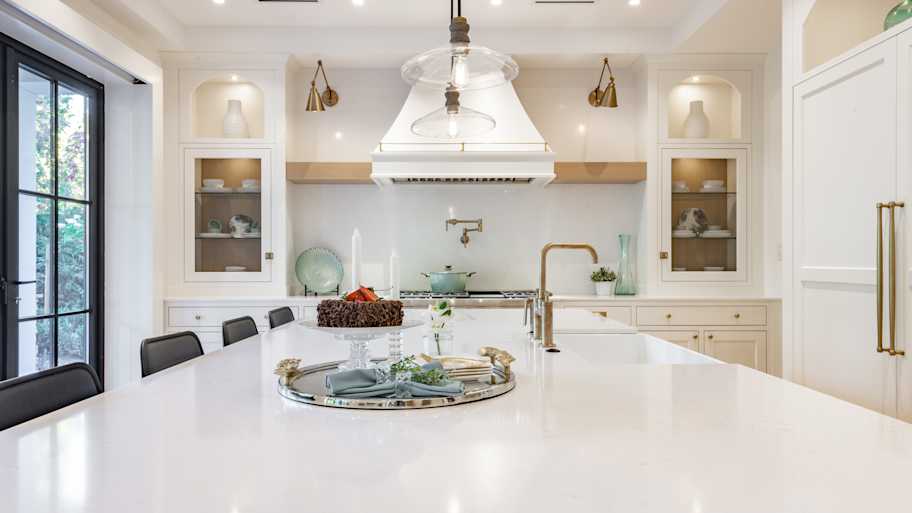
Countertop repair costs may be the deciding factor between replacing or repairing your counter. Let’s break down the cost to repair, resurface, or relaminate.
Add a bit of luxury to your kitchen with this modern edge option


Mitered edges offer a thick, luxurious look to a kitchen or bathroom.
This edge profile complements both traditional and modern styles.
Almost any countertop material can have a mitered edge.
The cost of a mitered edge is usually an upcharge of $15–$45 per linear foot.
Each element of your kitchen or bathroom plays a role in its atmosphere and appearance. A mitered edge countertop is a bold design choice that offers a beautiful, thicker countertop finish without the cost of cutting a slab of stone, quartz, marble, or other material. Learn all about a mitered edge, its pros and cons, costs, and if it’s right for your countertop.

A mitered edge is a seamless 90-degree edge that joins the top countertop surface with a second, smaller piece of countertop. The two pieces are cut at 45-degree angles and fused together for a seamless look. A mitered edge profile offers the appearance of a thicker slab of stone or granite or merges with a waterfall panel.
A mitered edge profile is a specialty edge that you can request from your local countertop installer and is distinct from a square edge. You can choose an apron size—the apron is the piece that hangs down vertically—between two and six cm. The thicker the apron, the greater the impression it leaves. You can also choose an eased mitered edge, which offers a rounded look where the two pieces join.
When creating a mitered edge, the pattern must match up precisely between the two pieces of countertop material. The slabs should be precisely cut and then mounted together so no joints are visible. A mitered edge takes skill, experience, and care—definitely one that's best left to a countertop expert.
Cutting thicker slabs of granite, stone, or marble is more costly, but making a mitered edge profile is a great way to achieve a wider look with any additional countertop material.
Choosing the type of countertop edge for your kitchen or bathroom can greatly impact how the room looks. Adding an apron with a mitered edge makes the countertop look wider and more luxurious. A mitered edge also allows for a waterfall countertop that runs vertically from the countertop to the floor.
A square edge, on the other hand, is less expensive than a mitered edge, but it doesn’t capture the same luxury. Square edges are standard and result in a standard look.
A mitered edge offers a contemporary finish but isn’t right for every space. Here are the main benefits and drawbacks of a mitered edge countertop:
| Pros | Cons |
|---|---|
| Elegant finish | Expensive |
| Easy to clean | Requires a pro |
| Modern | Heavy |
Adds an elegant finish to a kitchen or bathroom
Creates a thicker appearance or leads into a waterfall edge
Costs less than a new slab of granite, stone, marble, or other material
Gives the room a focal point or statement
Pairs well with modern and traditional designs
Easy to clean and maintain countertop
More expensive than a standard edge
Requires an experienced countertop installer
Cabinetry underneath must be able to support the weight of the extra countertop material

Mitered edge countertops appear in both kitchens and bathrooms and commonly on kitchen islands. This design element creates a focal point and contrast in the space. Mitered edges are also used as a smooth transition between different level countertops or extending the countertop to the floor with a waterfall panel.
An eased mitered edge is slightly rounded at the corner, while a standard mitered edge has a distinct 90-degree angle. The slight change in detailing can make a big statement, so review both styles before selecting.
Granite and quartz are the two most popular stone countertop materials among homeowners. Responses from 8,100 Angi customers show that 44.6% requested granite, while 29.3% chose quartz. Granite’s natural strength makes it well-suited for mitered edges, allowing for seamless corner designs and intricate profiles.
The cost of mitered countertop edges ranges from $15 to $45 per linear foot, in addition to the cost of the extra countertop material. In general, countertop pros offer standard edges that are included in the countertop price. Mitered edges are considered specialty edges that cost an upcharge plus material.
As you budget for your countertop installation cost, ensure that any cabinetry below can support the extra weight. You may need to upgrade your cabinetry, increasing your costs.
While some DIYers may think they can channel their inner contractor for this project, it is no easy task. Cutting 45-degree angles requires expert precision and the correct tools to create a seamless waterfall-like edge. One teensy miscalculation will not only create unsightly seams but can also impact the structural integrity of the entire project.
Professionals have the right tools, adhesives, and experience to handle heavy slabs safely. When investing in a statement countertop made from luxury materials, you want to get the installation right the first time so you don’t waste a bundle.
Very professional, polite and helpful. I would recommend him!
Raven and crew does absolutely fantastic job. They are very professional if any concerns were to occur with any of her work she always took responsibility and finished out with a great job. I have worked with her business for a year and have always been satisfied. Very trusted business and...
I had Ace Fireplace Services install custom chimney caps for my home, and the results are stunning. They fit like a glove and have added a touch of sophistication to my chimney. I can't recommend their services enough.
Precision and professionalism define Custom Paint Jobs LLC. We couldnt be happier.
Very professional and efficient with work. Answered each question I had with great knowledge and an informative response. Will be working with them again.
Window Depot did an amazing job on my deck. I wasnt sure what I wanted to do, but their composite decking was affordable and will last a long time. I am excited to have family over, and I am no longer embarrassed by my backyard. Jeff and the ground crew were polite, respectful, and caring for...
Great tree company, very professional and honest. Glad we found them, they had the best pricing
Maple Tree Service should serve as a mentor for other business! Customer service was superior and beyond expectation. Response to request was prompt. The representative was very courteous and proud of the company. Quote was given during initial visit and work date established. A follow up...
Eugene returned my call within minutes and was able to complete the job within a couple of days. Friendly and professional, and I feel his prices are reasonable.
We used Unique Hardwood Floor LLC three years ago to work on the floors of a 70 year old home that needed a great deal of work. Some floors needed repairs, some were replaced and others just needed to be refinished. It was a complicated job as they needed to blend the old and the new to...
From average costs to expert advice, get all the answers you need to get your job done.

Countertop repair costs may be the deciding factor between replacing or repairing your counter. Let’s break down the cost to repair, resurface, or relaminate.

Butcher block countertops are a popular and durable choice for active kitchens. Learn how much it costs to install butcher block counters and what factors may affect pricing.

Granite counters are durable and stylish, but if you’re wondering how much granite countertops cost, it’s time to dig into the details.

When it’s time for new countertops, this calculator will help you know how much countertop you need to complete your project.

Choosing between concrete and granite countertops is a big decision. They both have long life spans but very different looks and upkeep requirements.

If you’re weighing Formica vs. laminate, you may be wondering if the brand name is really better. The truth is all laminates come with pros and cons.